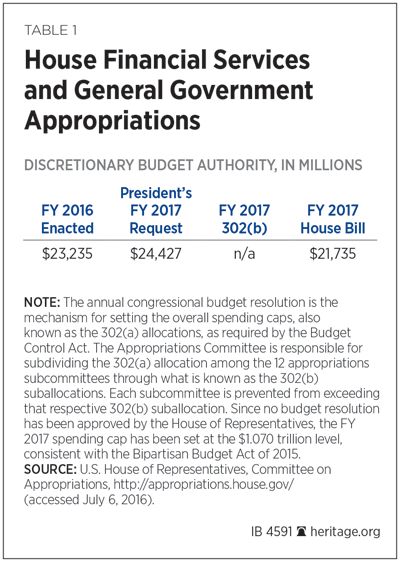This week, the House is expected to consider the Financial Services and General Government appropriations bill. This bill provides funding for the Treasury Department, the Justice Department, the Small Business Administration, and the Securities and Exchange Commission, among other agencies.
The fiscal year (FY) 2017 bill provides a total of $21.7 billion in discretionary budget authority. This represents a $1.5 billion decrease of the current funding level, and is $2.7 billion below the Administration’s FY 2017 budget request. The bill also includes important policy riders, such as prohibiting the use of funds for abortion in the Federal Employee Health Benefits program; prohibiting a pay increase for the Vice President and other senior political appointees; and additional prohibitions related to Cuba, among other provisions.
The Financial Services and General Government bill makes strides by cutting spending below the FY 2016 level; however, it still provides funding for programs that could be reduced further or eliminated entirely. This Issue Brief identifies additional areas where savings could be achieved as well as other policy alternatives that should be implemented.[1]
-
Small Business Administration (SBA). The bill includes $883 million in funding for the Small Business Administration, an increase of $12 million over the FY 2016 enacted level, and about $6 million more than the President’s FY 2017 request. This total includes $186 million for the Disaster Loans Program.
Currently, SBA disaster loans are awarded regardless of whether the beneficiaries previously took steps to reduce their exposure to losses from natural disasters. While SBA disaster loans are intended to help applicants return their property to the same condition as before the disaster, the unintended consequence of this requirement is that borrowers are forced to rebuild in disaster-prone locations. In many cases, the loans fail to offer a long-term solution, and thus should be eliminated.[2]
-
Securities and Exchange Commission (SEC). The bill provides $1.55 billion for the SEC, which is $50 million below the FY 2016 level, and $226 million below the Administration’s request. While reducing funding for the SEC is a step in the right direction, the bill could go further by freezing the budget at its inflation-adjusted FY 2015 level.
In FY 2007, the SEC had 3,567 full-time positions and a budget of $877 million.[3] For FY 2016, it has approximately 4,621 full-time positions and a budget of $1.68 billion.[4] Thus, over 10 years, the SEC staff has increased by 30 percent and its budget has grown 92 percent. Over that same period, overall federal spending increased 45 percent, inflation increased 15 percent, and the economy increased in size by 25 percent. Thus, the SEC budget has grown twice as rapidly as other federal spending over the past decade. For FY 2017, the agency has requested that its staff be increased an additional 5.4 percent, to 4,870 full-time positions, and that its budget be increased by 6.0 percent to $1.78 billion.[5] The SEC budget should be frozen at its real FY 2015 level.
-
Community Development Financial Institutions Fund (CDFI). This bill provides $250 million for the CDFI, an increase of $16 million from the FY 2016 enacted level, and $4 million above the FY 2017 request. The CDFI provides grants to community development financial institutions, community development entities, and other private financial institutions.
The CDFI fund should be shut down because it amounts to corporate welfare. Furthermore, the grants hinder competition and distort private markets, ultimately leading to higher consumer prices and further justification for increased federal spending.
Policy Riders
While the bill includes several meaningful policy riders, there are other important issues that should be addressed within this bill.[6] Congress should:
- Lift the moratorium on the Office of Management and Budget (OMB) Circular No. A-76 provisions. OMB Circular No. A-76 requires agencies to prepare an inventory of commercial (non-inherently governmental) activities and inherently governmental activities performed by government personnel. Small executive agencies with fewer than 100 full-time employees are exempt. There are 1.12 million federal positions that are commercial in nature. The Omnibus appropriations act of 2009 (P.L. 111–8) imposed a moratorium on public-private competition, and as a result none of the commercial positions identified by agencies has been subject to competition since FY 2009. The moratorium has been continued in subsequent appropriations bills and was last included in the Consolidated and Further Continuing Appropriations Act of 2015. The moratorium should be ended immediately and competition for commercial positions should be reopened.
- Repeal Dodd–Frank’s Title X. Title X of Dodd–Frank empowers the Consumer Financial Protection Bureau (CFPB) to regulate virtually every consumer financial product and service without direct oversight by Congress or the White House. The bureau is restructuring the mortgage market; devising restrictions on credit bureaus, education loans, overdraft policies, payday lenders, credit card plans, and prepaid cards; and amassing unverified complaints with which to assail creditors and bankers. Ample evidence shows that the bureau’s operations represent a radical departure from long-standing regulatory standards, and its inordinate control of consumer finance is constraining credit and harming the economy.[7]
- Limit and define the powers of the Consumer Financial Protection Bureau. Although elimination of the CFPB would be preferable, the bill does take a step in the right direction by bringing the CFPB under the annual appropriations process and making reforms to the leadership structure. Congress should go further by limiting and explicitly defining the CFPB’s powers.[8]
- End Operation Choke Point. This program, launched by the Justice Department in 2013, is advertised as a way to fight fraud by having banks “choke off” access to credit and banking services by industries that the Administration classified as a high risk for fraud. Critics of the plan believe that it has been used to target legal businesses, such as gun sellers, pawn shops, and short-term lenders.[9] Earlier this year, the House passed the Financial Institution Customer Protection Act, which would prohibit financial institutions from ending a banking relationship without a material reason. While some progress has been made, it is important for the bill’s provisions to be codified into law to prevent other agencies from taking similar actions in the future.
- Block small-dollar lending rules. The CFPB has proposed rules to regulate small-dollar lenders, such as those who provide payday, vehicle title, and other installment loans. The CFPB’s own estimates suggest that the new rules could eliminate up to 84 percent of the payday lending industry’s revenue.[10] These rules are based on the false premise that the industry harms consumers, and the CFPB’s own complaint database fails to support the bureau’s position.[11] There is ample evidence that the small-dollar industry benefits millions of consumers. Congress should block the CFPB’s new rules so that millions of Americans will not be cut off from a valuable source of credit.
- Require the SEC to revise the filing requirements of Regulation D. Regulation D provides exemptions from securities registration requirements. This would mimic H.R. 4852, which was recently approved by the Financial Services Committee and, among other provisions, would prevent the SEC from: (1) requiring the issuer of securities to file any notice of sales required by Regulation D other than the single notice of sales; (2) requiring issuers to submit general solicitation materials in connection with a Rule 506(c) offering, except when it requests such materials pursuant to specified authority; and (3) extending the requirements contained in Rule 156 to private funds. It would also revise Regulation D to provide that a person who is a “knowledgeable employee” of a private fund or the fund’s investment adviser would be an accredited investor for purposes of a Rule 506 offering of a private fund with respect to which the person is a knowledgeable employee.
Conclusion
The FY 2017 Financial Services and General Government appropriations bill makes progress by cutting more than a billion dollars from last year’s spending level and including several important policy riders. Bringing the CFPB under the annual appropriations process is a step in the right direction, but Americans would be better served if Congress eliminated it, and its harmful effects on the economy were reversed. Lifting the moratorium on OMB Circular No. A-76 is another important step toward restoring fairness and competition to the role of the federal government. The FY 2017 bill should take bold steps to reduce economic barriers in order to return the economy to a prosperous path.
—Justin Bogie is Senior Policy Analyst in the Thomas A. Roe Institute for Economic Policy Studies, of the Institute for Economic Freedom and Opportunity, at The Heritage Foundation. David R. Burton is Senior Fellow in Economic Policy in the Roe Institute. Norbert J. Michel, PhD, is a Research Fellow in Financial Regulations in the Roe Institute.




